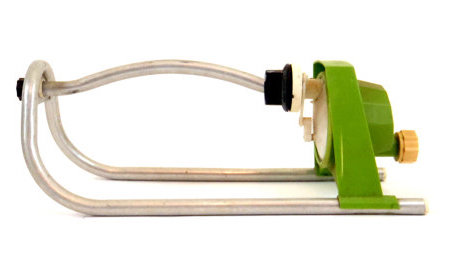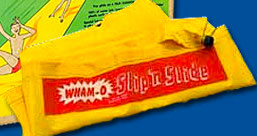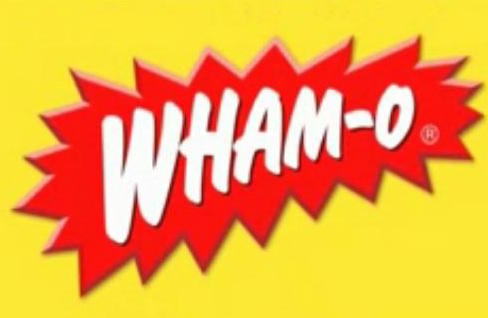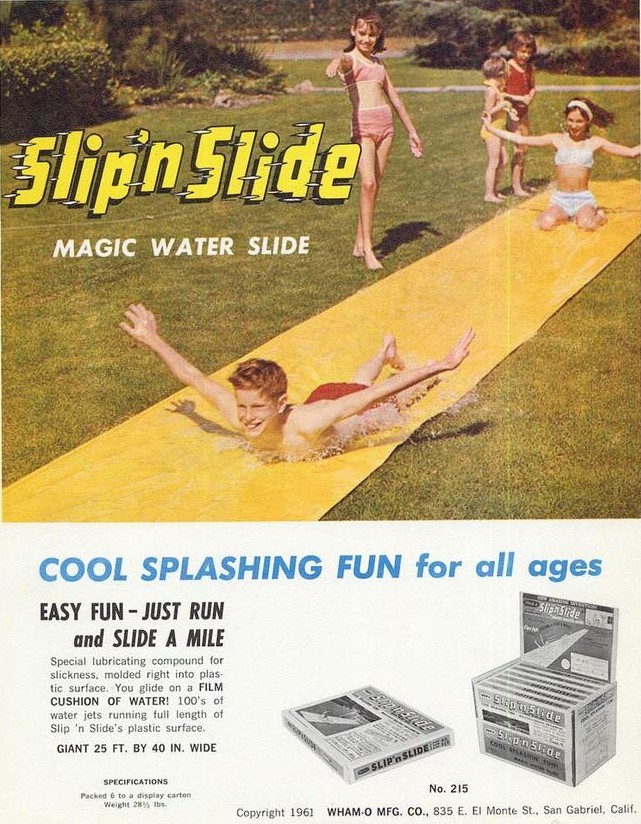Wham-O’s The Slip ‘N Slide held such promise. Such high hopes for the pool-less. Slip ‘N Slide was like a dangling promise of cool, wet summer fun for us hot and disgusted kids in the 1970’s who didn’t have a pool. For us, water sports were relegated to hopping back and forth over that stupid sprinkler on burning hot days.


The idea of cooling off and having fun at the same time by running up to – and then belly-flopping down on – a water-slicked length of slippery vinyl seemed, well, AWESOME. The roll-out backyard slide seemed like the answer to our prayers. “Easy Fun! Just Run and Slide a Mile! It’s Crazy! People Scoot Like Seals!” it boasted.
People Scoot Like Seals. I wanted that. I wanted to scoot like a fckng seal.
The Slip N’ Slide Deconstructed:
An upholsterer named Robert Carrier invented the Slip ‘N Slide and sold the idea to our friends at Wham-O Toys, who released the first ones way back in 1961.
Robert Carrier’s 1961 patent for what became the Slip ‘N Slide. (U.S. Patent and Trademark Office)
The toy was a long sheet of thin yellow plastic with a lengthwise heat-sealed tubular fold running down one side.
The tube attached to an ordinary garden hose so that water would project down the surface and supposedly create a slippery surface.
Robert Carrier called his idea “a portable aquatic play device for body planing.” Body planing, Carrier explained, referred to the practice of hurling oneself into shallow water then gliding (like a seal), across a slick coating of muddy earth.
The biggest problem with this piece of junk was that the the ideal natural environments for body planing and sliding did not exist in anyone’s backyard. If you were lucky enough to have a grassy yard, they tended to carry sharp and abrasive things sticking out. The Slip N’ Slide was perilously thin and didn’t have any padding, so we were basically hurling themselves onto a thin piece of plastic over pretty hard grass, rocks, mounds and sticks.

You also needed several other factors to successfully navigate the treacherous Slip ‘n Slide journey: Enough room for a good running start, and a soft landing for the end of the ride. Without the first, you wouldn’t travel very far. Rather, you’d end up with a hard thump on your ass a few feet from the start of the slide. Without the latter, and you are just flinging yourself to your doom out onto the sidewalk pavement or across the driveway, or onto a cement patio. I suffered all these. I skidded to a short stop onto the plastic, I overshot the end of the plastic, I scorched my ass on burning plastic, I ripped open skin on rocks hidden underneath the plastic. Still, I was one of the lucky ones…I careened into the metal brackets used to staple it to the grass, acquiring bruises all over my body while bumping over uneven divots of dirt.
The death merchants at W ham-O sold millions of Slip ‘N Slides over the years, and if a kid broke a toe on one of the stakes that secured the mat to the ground or punctured an ass on a rock hiding under the mat, left most of their epidermis on the driveway because they slid too far, or a teenager broke a neck, well it was the 1970’s. It wasn’t until the more litigious 1990s that words like “spinal cord injury” and “death” started appearing in the lengthy list of warnings included on the Slip ‘N Slide instruction sheet. Between 1973 and 1991, Slip ‘N Slide injuries included neck injuries, bone fractures, quadriplegia, and paraplegia. It is kind of amazing – and a testament to the time – to learn that this dumb toy was not recalled until 1993.
ham-O sold millions of Slip ‘N Slides over the years, and if a kid broke a toe on one of the stakes that secured the mat to the ground or punctured an ass on a rock hiding under the mat, left most of their epidermis on the driveway because they slid too far, or a teenager broke a neck, well it was the 1970’s. It wasn’t until the more litigious 1990s that words like “spinal cord injury” and “death” started appearing in the lengthy list of warnings included on the Slip ‘N Slide instruction sheet. Between 1973 and 1991, Slip ‘N Slide injuries included neck injuries, bone fractures, quadriplegia, and paraplegia. It is kind of amazing – and a testament to the time – to learn that this dumb toy was not recalled until 1993.
Thanks, mom!
